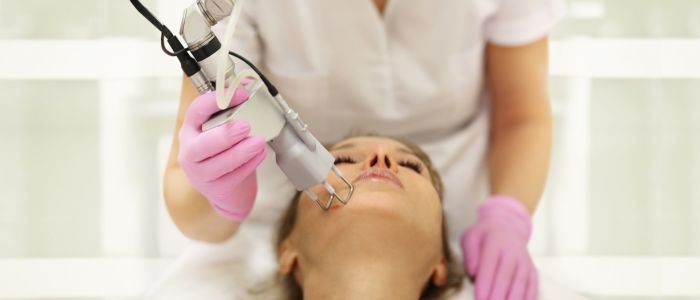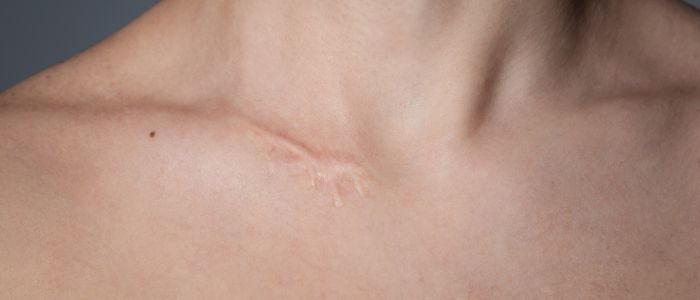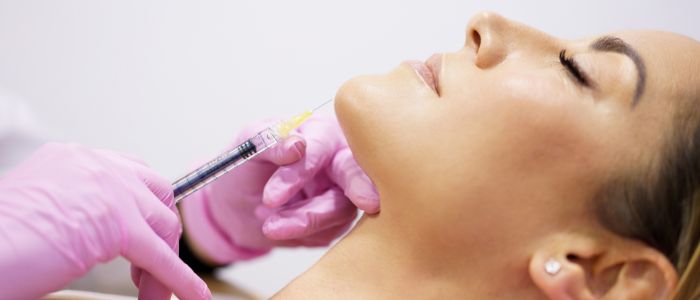
Table of Contents
- Advanced Scar Treatment Techniques
- What Are Scars?
- Why Treat Scars?
- Psychological Impact
- Choosing to Treat or Not to Treat
- Scar Treatment Options
- Topical Treatments
- Surgical Options
- Minimally Invasive Procedures
- Natural Remedies and Lifestyle Adjustments
- What to Expect from Scar Treatments
- Choosing the Right Treatment
- FAQs about Scar Treatment
- Further Reading about Procedures at Cheshire Cosmetic Surgery
Advanced Scar Treatment Techniques
When scars become a source of discomfort or self-consciousness, finding the right treatment option is important. In the field of plastic surgery, innovative techniques and personalised care can significantly improve and reduce the visibility of scars, enhancing both physical appearance and psychological well-being.
In this blog, Anca Breahna, a consultant plastic, reconstructive and aesthetic surgeon based in the UK, specialising in delivering state-of-the-art scar treatments tailored to meet the unique needs of each patient aims to discuss the various scar treatment options available today.
What Are Scars?
A scar is formed as part of the natural healing process following an injury. When the skin is damaged, the body forms new collagen fibres to mend the damage, resulting in a scar. The new scar tissue will have a different texture and quality than the surrounding tissue, which is why scars are often noticeable.
Scars come in various forms, each with unique characteristics:
- Keloid Scars: These are raised, dark-coloured lumps that grow larger than the original wound. Keloid scars are typically very noticeable and can continue to grow over time. They are more common in people with darker skin tones.
- Hypertrophic Scars: Like keloid scars, these are raised but remain within the boundaries of the original injury. They may decrease in size over time without treatment, but can remain prominent without intervention.
- Atrophic Scars: These appear as sunken recesses in the skin, often pitted or indented. Common causes include acne and chickenpox. Atrophic scars are challenging to treat because they involve a loss of skin tissue.
- Contracture Scars: These scars form after the skin burns. They cause the skin to tighten, which can impair your ability to move and might also go deeper, affecting muscles and nerves.
Why Treat Scars?
The decision to treat a scar can be driven by both aesthetic and functional reasons. From a psychological standpoint, scars might cause feelings of self-consciousness and anxiety, impacting one’s quality of life. Aesthetically, people might feel that reducing the appearance of scars will enhance their overall look, boosting confidence and self-esteem.
Functionally, some scars, particularly contracture scars, can significantly affect skin mobility and elasticity. Treating these scars can restore range of motion and reduce physical discomfort. For example, a contracture scar on a joint can severely limit movement and might require surgical treatment for relief.
Psychological Impact
It’s important to address the psychological impact scars can have. Many individuals feel a stigma associated with visible scars, especially on facial areas or other exposed parts of the body like hands and arms. This can lead to social anxiety and decreased social interaction. Effective scar treatment, therefore, not only improves the physical appearance but also helps alleviate mental health strains.
Choosing to Treat or Not to Treat
Deciding whether or not to treat a scar often depends on its location, size, and the emotional burden it imposes on the individual. Some people may choose to embrace their scars as symbols of a life lived and challenges overcome, while others might prefer to diminish them as much as possible. In either case, understanding the types of treatments available and their potential outcomes is essential for making an informed decision.
Scar Treatment Options
When considering scar treatment, it is important to understand that no single treatment fits all. Different techniques can be employed depending on the type and severity of the scar, as well as your skin type, overall health, and treatment goals.
The treatment of scars has evolved significantly with advancements in medical technology and plastic surgery. Treatments can be broadly categorised into topical treatments, minimally invasive procedures, and surgical options. Each category offers different benefits and suits different types of scars.
Topical Treatments
Topical treatments are often used for less severe scars, including superficial scars and those that do not cause significant physical discomfort.
- Silicone Sheets and Gels: These are among the most prescribed treatments for both hypertrophic and keloid scars. Silicone sheets can be applied to the scar area to help flatten and soften the scar by hydrating the tissue. They are non-invasive and can be a cost-effective option for daily use.
- Hydrating Oils and Creams: Products containing hyaluronic acid, vitamin E, and other moisturising ingredients can help keep the scarred skin soft and hydrated. This may reduce itchiness and prevent the scar from becoming worse due to dryness and cracking.
- Prescription Creams and Gels: These might include treatments like corticosteroid creams, which can help reduce inflammation, and tretinoin cream, which can decrease the appearance of scars over time by promoting skin cell turnover.
Surgical Options
For more severe cases, surgical options might be necessary to achieve significant improvements in the appearance of scars.
- Scar Revision Surgery: This procedure involves removing or altering the scar tissue to make the scar less noticeable. It can be beneficial for scars that are raised above the skin or are otherwise pronounced. Scar revision techniques vary, but they often involve cutting out the scar and meticulously suturing the new wound.
- Laser Treatment for Scar Reduction: Laser therapy can be an effective treatment for many types of scars, including surgical scars and acne scars. It works by using focused light therapy to remove or reshape damaged skin in a very precise manner. Different types of lasers are used depending on the scar type and your skin condition.
- Steroid Injections: Often used for hypertrophic or keloid scars, injections of corticosteroids can help reduce scar size by decreasing collagen build-up in the scar tissue.
Minimally Invasive Procedures
These procedures generally involve less downtime than surgery and can be an effective middle ground for treating scars.
- Dermal Fillers: For atrophic scars, dermal fillers can be injected under the skin to help raise sunken areas. This treatment can temporarily improve the skin’s appearance if the scar is caused by a loss of tissue, such as from acne or chickenpox.
- Microneedling: This involves using small needles to puncture the scarred skin and stimulate collagen production, which can lead to an improvement in the appearance of scars over time.
- Chemical Peels: Applying a chemical solution to the skin can remove the top layers and allow new skin to grow in its place. This might be particularly useful for discoloured or lightly textured scars.
Natural Remedies and Lifestyle Adjustments
In addition to medical treatments, certain natural remedies and lifestyle changes can support scar healing and improve overall skin health.
- Natural Oils: Oils such as coconut oil, tea tree oil, and lavender oil have properties that can help reduce scar visibility. These oils can help moisturise the skin and promote healing through their anti-inflammatory properties.
- Diet and Hydration: Maintaining a healthy diet rich in vitamins and minerals can support skin health, which is crucial for healing scars. Hydration is equally important; drinking plenty of water ensures that your skin remains supple and can heal more efficiently.
What to Expect from Scar Treatments
When considering options to improve the appearance of scars, having realistic expectations is important. Understanding what each treatment can realistically achieve helps set appropriate goals and reduces potential disappointment.
Realistic Outcomes
Different scar treatments offer varying degrees of success, and it’s important to have a clear understanding of what each can realistically accomplish:
- Topical Treatments: These are generally effective for mild scarring and can help to reduce redness and smooth out minor bumps. However, they are less likely to make a significant impact on deep or very noticeable scars.
- Surgical Options: Procedures like laser therapy and surgical revision can offer significant improvements, especially for severe scars. These treatments can significantly reduce the appearance of scars, making them less noticeable.
- Minimally Invasive Procedures: Treatments such as microneedling and dermal fillers can provide noticeable improvements in the texture and appearance of scars by promoting collagen production or filling in depressed areas.
Before and After Scenarios
To set realistic expectations, here are some typical before and after scenarios:
- Keloid/Hypertrophic Scars:
- Before: A raised, dark scar that is noticeable at a distance
- After: Post-treatment with steroid injections or laser therapy, the scar may be less raised and lighter in colour, blending more with the surrounding skin
- Atrophic Scars:
- Before: Sunken, pitted scars from acne or chickenpox
- After: Filler injections or laser resurfacing might raise the depth of the scar, making it less noticeable and more even with the surrounding skin
Timeline for Scar Improvement
The improvement timeline can vary widely depending on the treatment method chosen:
- Topical Treatments: Improvement can be seen in as little as a few weeks, but continuous use over several months is often necessary for significant changes.
- Surgical and Laser Treatments: These may require several sessions spaced a few weeks apart, with final results visible several months after the last treatment as the skin heals and new collagen forms.
- Minimally Invasive Procedures: Results can vary; microneedling might show results after a few sessions, while fillers can offer immediate improvements.
Choosing the Right Treatment
Selecting the right scar treatment involves being aware of the specific characteristics of your scar, your personal health, and your treatment goals.
Factors to Consider
Here are key factors to help determine the best treatment option:
- Scar Type and Location: The type of scar (keloid, hypertrophic, atrophic, contracture) significantly influences treatment choices. For example, keloid scars may respond well to steroid injections, whereas atrophic scars might benefit from dermal fillers.
- Severity of the Scar: More severe scars might require more aggressive treatments such as surgery or laser therapy.
- Personal Health and Skin Type: Some treatments might not be suitable for all skin types or those with certain health conditions. Always consider these factors to avoid adverse reactions.
- Consulting with a Plastic Surgeon: A professional can offer invaluable advice and ensure that the chosen treatment is suitable for your specific needs.
Consultation Process
Understanding what to expect during a consultation can help prepare you for the steps involved in selecting a scar treatment plan:
- Initial Assessment: Anca will first assess the type, severity, and location of your scar. This involves a detailed examination and possibly taking photographs for a more accurate evaluation.
- Discussion of Options: Based on the initial assessment, Anca will discuss the most appropriate treatment options. This includes explaining the pros and cons of each option, expected outcomes, and any potential risks.
- Personalisation of Treatment Plan: The treatment plan will be tailored to your specific needs. This might include a combination of treatments to achieve the best results.
- Follow-Up: Setting up follow-up appointments to monitor the progress and make any necessary adjustments to the treatment plan.
By entering the consultation with realistic expectations and a clear understanding of the possible treatments, you can significantly enhance your overall satisfaction with the scar treatment process.
FAQs about Scar Treatment

Can scar treatments completely remove my scar?
It is important to understand that while scar treatments can significantly reduce the appearance of scars, they rarely completely remove them. The goal of treatment is to make the scar less noticeable and more similar to the surrounding skin texture and tone.
Are scar treatment results permanent?
The permanency of scar treatment results can vary depending on the type of treatment and the nature of the scar. For example, treatments like surgical revision and laser therapy might provide long-lasting results, while others, such as filler injections for atrophic scars, may require periodic repeats to maintain the aesthetic improvement.
How can I tell if a scar is likely to improve with treatment?
Some scars, such as those that are newer and less severe, are generally more responsive to treatment. Scars that are older and more established might not respond as well. Consulting with a specialist like Anca can provide a more accurate assessment based on a detailed examination of the scar.
Does insurance typically cover scar treatment?
Coverage for scar treatment can vary widely by insurance provider and policy. Generally, scar treatments that are deemed medically necessary (such as those that restore function or correct severe disfigurement) are more likely to be covered than treatments sought for purely cosmetic reasons. It is advisable to check with your insurance provider for specific details regarding coverage.
What should I do to prepare for scar treatment?
Preparation for scar treatment can include several steps, depending on the type of treatment planned:
- Medical Evaluation: Providing a full medical history and details of any medications you are currently taking is essential.
- Skin Care: Depending on the treatment, you may be advised to avoid certain medications or follow specific skin care routines leading up to the treatment to minimise risks and improve outcomes.
- Practical Arrangements: For treatments that may require downtime, arranging for time off work and help at home can ensure a smooth recovery.
References about Scar Treatment
- A comprehensive evidence-based review on the role of topicals and dressings in the management of skin scarring: https://pubmed.ncbi.nlm.nih.gov/35255673/
- Research progress of scar repair and its influence on physical and mental health: https://pubmed.ncbi.nlm.nih.gov/35164671/
- Immunological mechanisms of scarring and their psychological impact on patients: https://pubmed.ncbi.nlm.nih.gov/35431501/
- Topical treatments for hypertrophic scars: https://pubmed.ncbi.nlm.nih.gov/36429042/
- The Effectiveness of Topical Anti-scarring Agents and a Novel Combined Process on Cutaneous Scar Management: https://pubmed.ncbi.nlm.nih.gov/34349792/
Further Reading about Procedures at Cheshire Cosmetic Surgery
- Read more about Treatment for Scars
- Read more about Scars after Labiaplasty
- Read more about What Can Be Done to Reduce Eyelid Surgery Scars?
- Read more about How to Get Rid of Old Scars
- Read more about Silicone Strips for Cosmetic Surgery Scars
- Read more about Skin Condition – Scars









